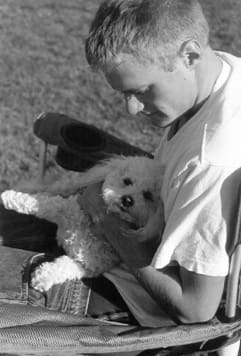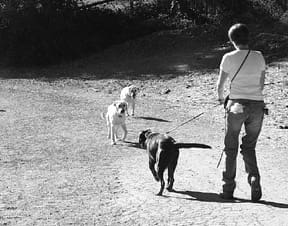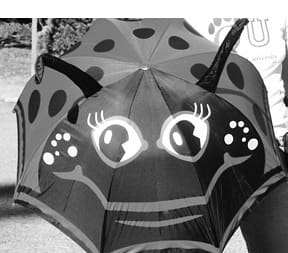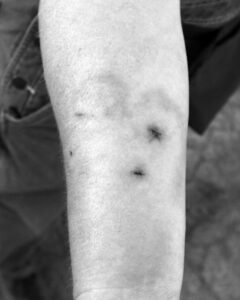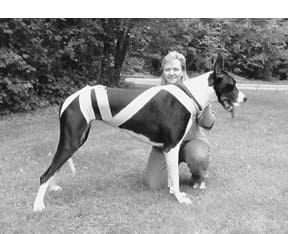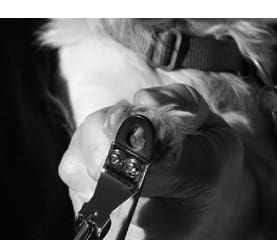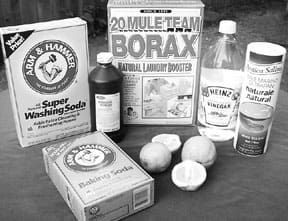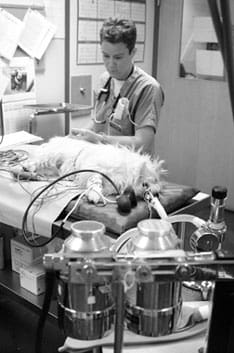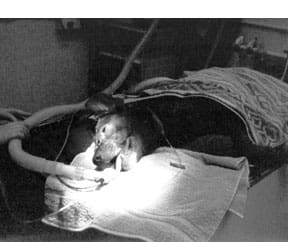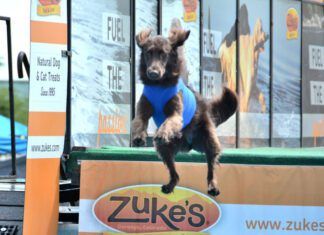Few issues in veterinary medicine are as controversial as the debate about administering annual vaccinations to our dogs. Long considered part of the standard of baseline, responsible veterinary healthcare, and credited with conquering some of the fiercest canine viral and other infectious diseases, vaccinations now are also suspected of creating vulnerability to illnesses and chronic conditions such as anemia, arthritis, seizures, allergies, gastrointestinal and thyroid disorders, and cancer.
As we’ve previously discussed in numerous articles, few people advocate refraining from the use of vaccinations altogether, but increasing numbers of veterinary experts recommend administering fewer vaccines to our dogs than was suggested in recent years. The current wisdom is to vaccinate our animal companions enough, but not too much.
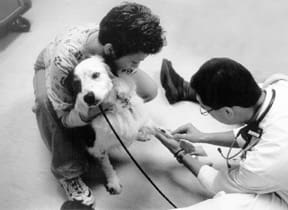
Does this seem a little arbitrary? It could, especially since the veterinary profession lacks complete information about exactly how long the effects of canine vaccines last. (We bet you thought that most vaccines “last” about a year, which is why you are supposed to bring your dog to the vet for more shots every year, right? Well, you’re wrong, and we’ll explain why below.)
Fortunately, there is a tool that veterinarians and dog owners can use to determine whether or not a dog really needs further vaccination at any given time. It’s called a “titer test,” and it’s readily available, not terribly expensive, and offers multiple advantages over the practices (intentional or not) of over-vaccination and under-vaccination.
To understand what a titer test is and what it can do for you and your dog, you need a little background information about vaccinations and their use in this country.
History of “recommended vaccine schedules”
As lifesaving vaccines for various canine diseases have been developed over the last 50 years, veterinarians and dog owners gladly embraced them. Many diseases were prevented, and a new industry was born. Like any industry, it soon set about making itself indispensable. Increasingly, veterinarians were sold on the concept that if some vaccines are good, more are better – for their patients and their bottom line. So it came to pass that for decades, vets followed the label recommendations directing that canine vaccines be administered annually.
In the late 1970s, a deadly parvovirus epidemic killed thousands of dogs and wiped out whole litters of puppies, eventually halted by the mass administration of the parvovirus vaccine. This episode emphasized the important role of vaccinations in canine healthcare and labeled veterinarians who challenged the annual administration of vaccines as mutinous.
And there was, in fact, a small population of insurgent veterinarians who had doubts about the necessity of frequent vaccination. Many holistic practitioners – who often see patients with complex, mystifying symptoms of poor health, patients who have not been helped or even diagnosed by conventionally trained veterinarians – suspected a link between vaccines and immune disorders. In their minds, it was easy to surmise that there might be a connection between agents that are designed to provoke an immune response and their patients’ poor or inappropriate immune responses.
But while drug companies are motivated to fund studies that can develop more vaccines they can sell for a profit, they are understandably disinclined to spend money on studies that may discover their products’ potential for harm, or how few vaccines our companion animals really need for disease protection. As a result, only anecdotal evidence provided by “vaccine rebels” – owners and veterinarians who either do not vaccinate or vaccinate on a reduced schedule – seemed to suggest that dogs and cats might be better off receiving fewer vaccines. But until recently there was little scientific evidence that supported this idea, perhaps none that was accepted in the conventional university veterinarian research community.
Then, in the early 1990s, laboratory researchers at the University of Pennsylvania noticed a connection between the marked increase in the number of sarcomas, or cancerous tumors, under the skin at the site of rabies vaccine administration in cats. Later, researchers at the University of California at Davis noted that feline leukemia vaccines seemed to cause the same results. Taken aback by the inflammatory nature of the animals’ reaction to the vaccines, veterinary researchers began to suspect that immediate reactions to vaccinations, delayed reactions to vaccinations, or the combined effects of multiple vaccinations, could be risk factors for other ailments and chronic diseases in cats and dogs.
As vaccines and their long-term effects became a (at least minor) topic of mainstream veterinary interest, one small but important fact came to light: there is no universally accepted “standard vaccination protocol” that has the approval of say, the American Veterinary Medical Association and/or the FDA’s Center for Veterinary Medicine. The prevailing vaccination recommendations and schedules that most veterinarians and veterinary colleges recommend have been based on the research and suggestions of the manufacturers – not on independent scientific research. This point had long been recognized by the vaccine rebels, but disregarded by most conventional veterinarians.
Why more is not better
Jean Dodds, DVM, a highly respected veterinary hematologist, and founder and president of the nonprofit Hemopet, a California-based animal blood bank, pioneered the vaccine debate decades ago and is now considered one of the leading authorities on canine vaccine protocols. According to Dr. Dodds, many recent studies confirm that the vast majority of dogs, in most cases at least 95 percent of the subjects, retain immunity after vaccination for many years after the administration of a vaccine. She states that the “evidence implicating vaccines in triggering immune-mediated and other chronic disorders (vaccinosis) is compelling.”
Adverse reactions to conventional vaccines can be the same as reactions to any chemicals, drugs, or infectious agents. Immediate (or anaphylactic) reactions can occur in the 24-48 hours following exposure to the vaccine. Delayed reactions can occur 10-45 days after receiving vaccines. Symptoms include fever, stiffness, sore joints, abdominal tenderness, nervous sys-tem disorders, susceptibility to infections, and hemorrhages or bruising. Transient seizures can appear in puppies and adults.
More long-term harmful effects can result in permanent damage to the dog’s immune system, which increases the dog’s susceptibility to chronic, debilitating diseases affecting the blood, endocrine organs, joints, skin, central nervous system, liver, kidneys, and bowel.
In addition, vaccines can overwhelm a chronically ill dog, or a dog that has a genetic predisposition to react adversely to viral exposure, even from the modified live viral agents or killed virus in vaccines.
So, given the possible health risks of administering too many vaccines, especially when a dog likely retains the immunologic protection supplied by previous vaccinations, how can a responsible dog owner decide on a safe and effective vaccine schedule for the life of their dog? As we suggested earlier, the answer is titer tests.
Understanding titer tests
The term “titer” refers to the strength or concentration of a substance in a solution. When testing vaccine titers in dogs, a veterinarian takes a blood sample from a dog and has the blood tested for the presence and strength of the dog’s immunological response to a viral disease. If the dog demonstrates satisfactory levels of vaccine titers, the dog is considered sufficiently immune to the disease, or possessing good “immunologic memory,” and not in need of further vaccination against the disease at that time.
Titer tests do not distinguish between the immunity generated by vaccination and that generated by natural exposure to disease agents. A dog may have developed immunity to a viral disease by receiving a vaccine against the disease, by being exposed to the disease in the natural environment and conquering it, sometimes without having demonstrated any symptoms of exposure to the disease, or by a combination of the two.
Therefore, titer tests really measure both the “priming of the pump” that comes from vaccines, and the immunity resulting from natural exposure to disease during a dog’s lifetime. Only an indoor dog that has been totally sequestered from the natural environment is likely to have developed all of its immunity from vaccinations.
Although the magnitude of immunity protection received by vaccination only is usually lower than by vaccination plus exposure, it doesn’t matter how your dog developed its strong immunity to specific viral diseases, as long as the immunity is present. By “titering” annually, a dog owner can assess whether her dog’s immune response has fallen below adequate levels. In that event, an appropriate vaccine booster can be administered.
Which titers tests?
Some dog owners, aware that there are dozens of vaccines available, are concerned that they would need to order titer tests for each vaccine. Actually, measuring the titers for just two vaccines, according to Dr. Dodds, can offer the dog owner a reliable “picture” of the dog’s immunological status. Good immunity to canine parvovirus (CPV) and canine distemper virus (CDV), she says, indicates proper “markers for the competence of the dog’s immune system.”
Although the laboratories will also perform vaccine titer tests for other canine diseases, such as coronavirus and Lyme, Dr. Dodds deems these tests a waste of money. Protection from coronavirus, Dr. Dodds explains, depends on the current state of health of the dog’s gastrointestinal tract, not on what’s in the dog’s blood, so serum tests are not conclusive. Lyme is regionally based and not a significant threat to the general canine population, so only dogs in a high-risk environment need titer testing for Lyme.
Dr. Dodds emphasizes that titer testing is not a “guess” at immunological response in a dog; when dealing with CDV and CDP, there is absolute correlation between certain high titer values and what is frequently referred to as “protection” from the diseases in question. In this case, the animal’s owner and veterinarian can feel quite confident that the animal possesses sufficient resources for fighting off a disease challenge.
When the tests reveal that the animal has borderline or low titer values, the owner and veterinarian should consider revaccinating and then testing the titers again. It may turn out that the animal simply needed a booster to stimulate a stronger immune response. Or, maybe the people involved learn that the animal lacks the ability to respond normally to vaccines, that is, by mounting a proper immune response. In this case, the owner and veterinarian have gained very valuable information about the dog’s compromised immune status – information they never would have gained by simply vaccinating and assuming the dog was “protected” as is usually the case with healthy dogs.
As you can see, in reality, simply administering vaccines to dogs every year is more of a guessing game than using titer tests to learn about the dog’s immune competence. Studies worldwide support titer test results as comprehensive information about a dog’s immunological response capabilities.
Now more affordable
Because the more widely recognized benefits of titer testing have caused an increase in the number of titer tests performed at veterinary laboratories, the price is coming down and the tests are available from a wide range of providers.
Veterinary laboratories offer traditional vaccine titer testing by looking at a blood sample from a dog and identifying a specific level of actual immunity in the dog. Reputable laboratories use commonly accepted immunological techniques that have been validated against original test techniques and found to be accurate. Be certain your veterinarian sends blood samples to a major professional veterinary laboratory such as Antech Diagnostics (www.antechdiagnostics.com), Idexx Laboratories (www.idexx.com), Vita-Tech Laboratories (www.vita-tech.com), or one of the major university veterinary laboratories, including Cornell, Colorado State, Michigan State, Tufts, and Texas A&M.
In early spring 2002, Synbiotics Corporation, a San Diego-based manufacturer of diagnostic materials and instrumentation for the veterinary market, rolled out an innovative tool that should make titer testing even more readily available and affordable. TiterCHEKTM is the first in-office titer test licensed by the USDA for use in veterinary clinics. TiterCHEKTM tests titers for canine parvovirus and canine distemper virus, registering the degree of strength of the immune response in varying color shades. If the test results denote a weak immune response level, blood samples can be sent to a veterinary laboratory for more comprehensive testing. Dr. Dodds estimates that more than 95 percent of in-office tests will indicate a satisfactory immune response present in a dog that has received its puppy vaccinations and one-year boosters, so follow-up is rarely required.
Expect to pay your veterinarian from $40 to $100 for CDV and CPV titer testing from a laboratory, and slightly less for an in-office test, for which your veterinarian must purchase the TiterCHEKTM test kit.
Resisting vaccine titer testing
As practicing clinicians, veterinarians are hesitant to adjust any clinical regimen they have adopted until they see research study data that they judge to be functional and applicable in the real world. Many veterinarians resisted rethinking the annual canine vaccine regimen based upon the early findings of researchers.
However, the increased evidence linking over-vaccination to acute and chronic diseases in dogs has finally caused a mainstream conviction that vaccination protocols are not a one-size-fits-all healthcare decision. Indeed, Dr. Dodds, once considered a rebel by the veterinary profession, now speaks to standing-room-only audiences at the most prestigious professional conferences in the country.
The perceived need for annual vaccinations used to motivate many dog owners to make appointments with their veterinarians for their dog’s annual wellness checkup. Veterinarians now hope that annual titer tests will perform a similar function. Having your dog examined by a veterinarian at least once a year is critically important for detecting, preventing, and treating any diseases or other ailments as early as possible. Adding the ability to check your dog’s immunological health and custom-tailor his vaccine schedule to his actual needs will impressively augment this important task.
It has been estimated that only about 60 percent of pet dogs receive the minimum disease prevention vaccination protocol. Ironically, in an attempt to provide their beloved animal companions with the best possible care, many highly motivated owners arrange for their dogs to receive several times the necessary dose of vaccinations, to the point of risking the adverse effects of over-vaccination on the health of the dog’s immune system.
Consumers who do care about managing the effectiveness of their dog’s immune system against the most dangerous canine viral diseases now have the means to do so without risking their dog’s health in the process. When you and your dog visit your veterinarian for an annual checkup, take the titer test.
Also With This Article
Click here to view “Vaccine Titler Tests for Dogs”
Click here to view “Titler Tests and Preventing Overvaccination”
Click here to view “Beware of Over-Vaccinating Your Dog”
Lorie Long is a frequent contributor to WDJ. She lives in North Carolina with two Border Terriers, Dash (a three-year-old female and agility queen) and Chase (a five-month-old male with an agility future).


